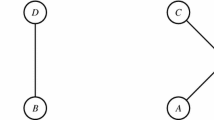Abstract
Contemporary physics has no answer to the question: What are the ultimate constituents of physical reality? (The variety of quarks hypothesized, and the multiplicity of their assumed properties, make it increasingly difficult to regard them as the ultimates.) The approach to an answer that is proposed in this paper starts with the assumption that there are utterly simple, uncomposed, indivisible elements and elemental events; and then attempts to draw inferences from this assumption, and particularly from the representation of the elements and events assumed. If such representation can be shown to be a uniquely necessary consequence of the Assumption of Elementality and its corollaries, then, from the permitted transformations of the representation, inferences could be derived about the possible and probable structures and processes of spacetime, energy, and matter.
Similar content being viewed by others
References
R. Hofstadter,Nuclear and Nucleon Structures (Benjamin, Reading, Mass., 1963).
W. Heisenberg, inThe Physicist's Conception of Nature, J. Mehra, ed. (D. Reidel, Dordrecht, Holland, 1973), pp. 272–3.
W. Heisenberg,Physics Today 29(3), 32–39 (1976).
W. Heisenberg,Physics and Philosophy (Harper, New York, 1958), p. 73.
D. Bohm,Causality and Chance in Modern Physics (Routledge & Kegan Paul, London, 1958); D. Bohm and J. Bub,Rev. Mod. Phys. 38, 453 (1966); L. de Broglie,Introduction to the Vigier Theory of Elementary Particles (with chapter by J.-P. Vigier) (Elsevier, Amsterdam and New York, 1963).
C. A. Hooker, inParadigms and Paradoxes, R. G. Colodny, ed. (Univ. of Pittsburgh Press, 1972), p. 211.
I. V. Kuznetsov and M. E. Omel'yanovskii, eds.,Philosophical Problems of Elementary Particle Physics (Daniel Davy & Co., New York, 1965).
D. Finkelstein and G. McCollum, inQuantum Theory and the Structures of Time and Space, L. Castell, M. Drieschner, and C. F. von Weizsäcker, eds. (Carl Hanser Verlag, Munich, 1975), p. 15.
J. G. Denbigh,An Inventive Universe (Braziller, New York, 1975).
F. P. Ramsey,The Foundations of Mathematics (Harcourt, Brace, New York, 1931).
T. Bastin, inQuantum Theory and Beyond, T. Bastin, ed. (Cambridge Univ. Press, 1971).
Author information
Authors and Affiliations
Rights and permissions
About this article
Cite this article
Spigelman, J.H. Toward an elemental grounding of microphysics. Found Phys 8, 759–785 (1978). https://doi.org/10.1007/BF00717505
Received:
Issue Date:
DOI: https://doi.org/10.1007/BF00717505




